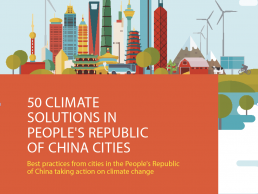First appeared in

Asian Development Bank
50 climate solutions from cities in the People's Republic of China
One of the PRC’s earliest market-based Emissions Trading Schemes boasts of impressive success metrics, and is also providing lessons for the other PRC mitigation projects.
Shanghai is the PRC’s most populous city and an important financial center for the country. It was in Shanghai where one of the first Emissions Trading Scheme (ETS) pilots was launched in 2013. ETS creates a carbon market where emitters can buy and sell credits that permit them to emit greenhouse gases. It creates an e¡cient market mechanism and means that companies who can make low-cost reductions in emissions receive a financial incentive to do so. Despite continued population, urbanization, and industrial growth predictions, the PRC has committed to peaking emissions by 2030 and reducing carbon intensity of GDP 60%–65% by 2030. Market-based policy tools like ETS can help the PRC realize its ambition of decoupling growth from emissions.
100%
COMPLIANCE OVER THE PAST 4 YEARS.
Around 60% of the city’s total emissions are covered by the ETS, which involves over 300 enterprises across a diverse range of sectors. Uniquely, the Shanghai ETS also includes the aviation sector, unlike many other similar schemes around the world. Since its creation, a total of 26.7 million emissions allowances have been traded, representing CNY414 million. ADV provided technical assistance for this project.

Shanghai’s Emissions Trading Scheme encourages the lowest-cost reductions in greenhouse gas emissions from industry and transport (photo by Lie Wu).
The Challenge
Shanghai’s cost of carbon has fluctuated from CNY10.14 to CNY38.38, creating uncertainty in the carbon market, slowing the progress of emissions reductions, but long-running projects like Shanghai’s ETS can provide insights into the technical design for the PRC’s national policy.
Co-Benefits
Economic Since the initiation of the ETS, a total of 26.7 million emissions allowances have been traded, representing CNY414 million.
Environment The scheme is estimated to have saved around 300 million tons of CO2 equivalent since its inception in 2013.
Health Reducing emissions is also associated with improving air quality—one of Shanghai’s greatest health-related problems.

